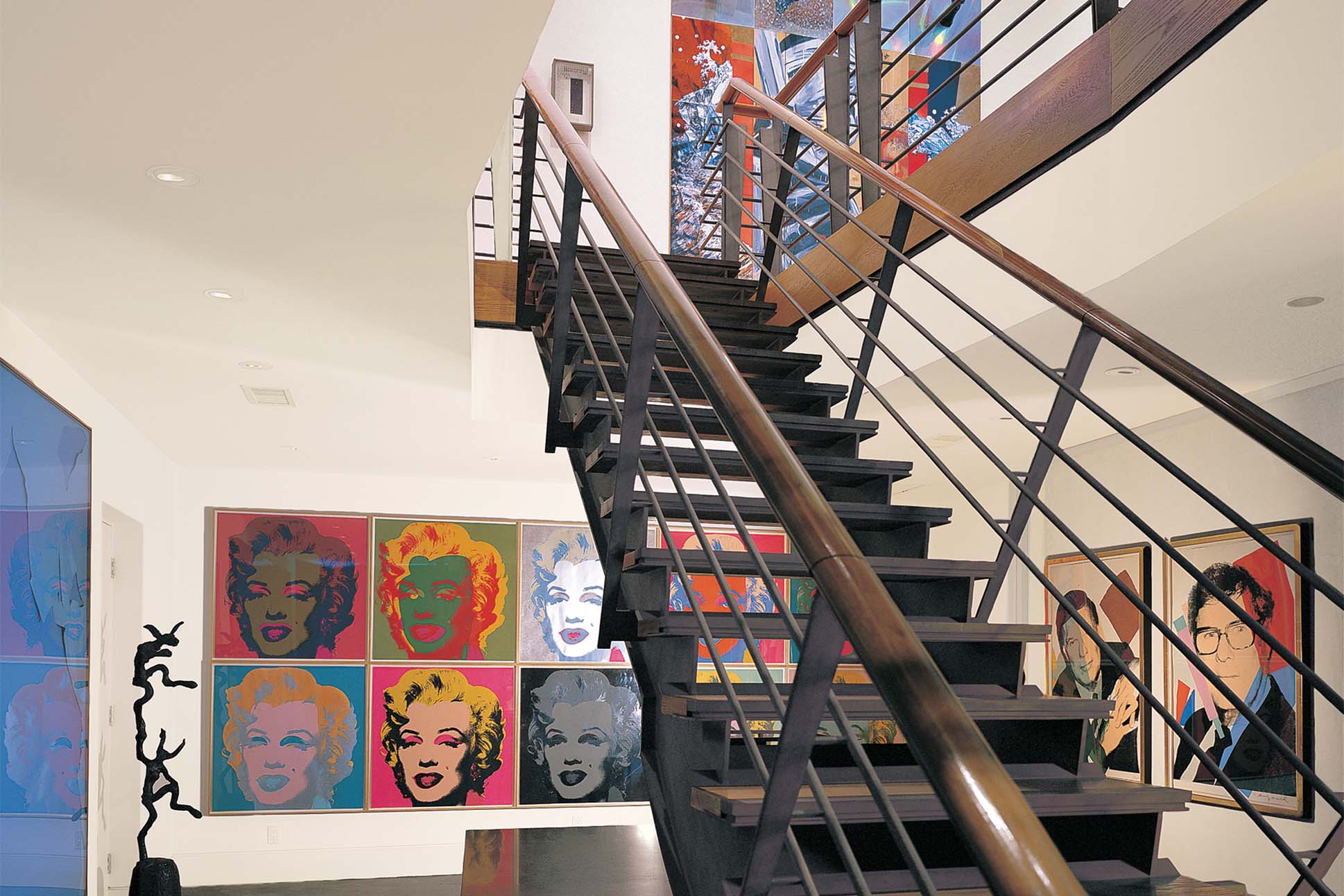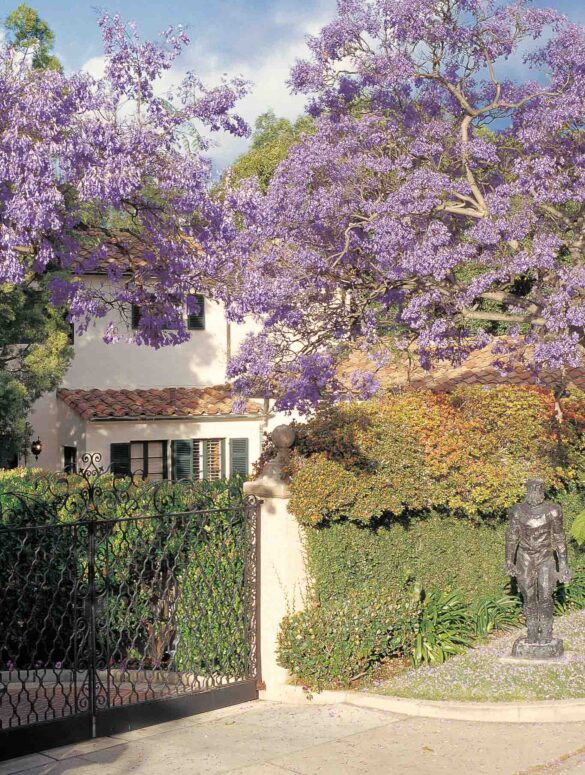Text by Kathy A. McDonald
Images courtesy of The Weisman Foundation
Imagine acquiring piece-by-piece one of California’s most impressive contemporary art collections, filling your house with these museum quality artworks and then sharing them with the world. The late businessman Frederick R. Weisman and his wife Billie Milam Weisman did just that in 1994 when they officially opened their grand Mediterranean Revival style house to the public after years of private tours. Since then, the house and sculpture-filled grounds of the Frederick R. Weisman Art Foundation, on a steep canyon in Los Angeles’ posh Holmby Hills neighborhood, have been open to the public most weekdays for free, guided tours.
This one-of-a-kind art tour gives visitors the experience of seeing artworks out in the wild, rather than within a white cube, white-walled gallery or a frosty museum setting. Instead, art fills every room, walls and even some ceilings of the well-lived, 1928-built manse decorated with upholstered chintz-covered furniture and personal effects. Frederick Weisman’s photos are at bedside, his ties still hang in the closet and a cheery photo of him sits next to a striped Frank Stella. In the photo, his bold tie’s colors coordinate with the painting.
“Basically, everything is as when we were living here,” explains Billie Milam Weisman of her late husband Frederick’s (Fred) intentions. “Fred wanted all the furnishings, and everything left when we moved out.” And that everything is a remarkable treasure trove of 400 works of blue-chip modern art by 175 artists.


Visitors’ wows start at the front door where a brilliant Fernand Léger mosaic is to the right; inside the grand foyer, the stairwell is topped by a Keith Haring Radiant Baby diptych while a Helen Frankenthaler bronze screen sits close by. Architecture is superlative too: Gordon B. Kaufmann was the original architect, known for the Greystone Mansion a/k/a the Doheny Mansion and the 1935-built Los Angeles Times building. Outside there are monumental sculptures dotting the manicured grounds by Fernando Botero, Henry Moore, L.A.-favorite son Robert Graham and other art-world bold names.
Guests can picture themselves lying in bed and waking up to Ed Ruscha’s lacquered wood folding screen, Remember and Forget, of blue clouds and Elvis Presley song lyrics in relief. Or looking out across the TV room to Red Grooms’ painted collage sculpture of Venice, with famed modern art collector and patroness Peggy Guggenheim holding court on her palazzo’s terrace overlooking the Grand Canal. Her house museum (now called the Peggy Guggenheim Collection) in part inspired Weisman’s decision to open his house to the public.
“Fred was so in admiration of Peggy Guggenheim, and he also wanted to call this the Frick [the Frick Collection on New York City’s upper east side] of the West. He absolutely thought that it was phenomenal that she had the house museum, but this is even more personal because they took a lot of her furnishings out of her house,” further elucidates Billie Milam Weisman. Works by well-known artists are juxtaposed carefully but do not follow a chronological or even alphabetical order. They do reflect Weisman’s sense of humor and eclectic tastes. “He was very quirky and he was brilliant in a very entrepreneurial way,” Weisman says her businessman husband who helped establish Hunt Foods and was one of the first Toyota distributors in the U.S.


He began collecting in the 1950s and continued pursuing his passion throughout his life until his death in 1994. His approach to acquiring art came from the heart. “He taught me—just use your eyes and your heart,” and to find work that spoke to her, Mrs. Weisman explains. She defers when asked to name her favorite piece. “Every day I gravitate towards one or the other and different times through the day when the sunlight comes in. I have many favorites,” she says.
The array of standouts inside the house is impressive and includes major work from the vibrant black-and-yellow Clyfford Still abstract in the entry foyer to an early Willem de Kooning Dark Cloud, painted utilizing house paint, and his figurative Pink Angels, representing a turning point in his career. A Mark Rothko color field painting dominates the living room under ornate stenciled beam ceilings. A granite Wave in Space coffee-table like sculpture by Isamu Noguchi sits alongside a chintz-covered couch. The dining room is a surrealist dream with bowler-hatted men under crescent moons via The Mysteries of the Horizon by Rene Magritte and one of his figurative woman’s bronzes along with works by Joan Miro and Max Ernst (also famously collected by Peggy Guggenheim).
When the house overflowed with artworks, the couple added an annex designed by Gehry protégé, architect Franklin Israel in 1992. Upstairs under a soaring ceiling are larger pieces by Frank Stella and Donald Judd plus two mixed media motorcycles hand painted by Keith Haring; downstairs a complete series of Ten Marilyns by Andy Warhol is tucked under the staircase. To be able to see such an impressive array close-up is a gift. Billie Milam Weisman explains her husband’s altruism thusly, “He really felt so blessed that he was able to have all of this that he really felt an obligation not only to share, because people deserve to see it, but he felt you owe it to the artist if you have it, you shouldn’t hoard it and lock the doors, you should share it.”


Although works were moved frequently when Frederick Weisman was alive, except for a rare exhibition loan, the layout is almost exactly how he envisioned it. In addition to those on display, the Foundation owns about 1,700 works in total, which are available for loan to other institutions. Recent exhibitions include a contemporary art overview at California State University Los Angeles (curated by Billie Milam Weisman) in 2024 that featured 50 works from the collection. Recognized for his cultural philanthropy, Weisman’s legacy includes funding the Frederick R. Weisman Museum of Art at Malibu’s Pepperdine University and the architect Frank O. Gehry-designed, Weisman Art Museum (WAM) at the University of Minnesota, Minneapolis.
There are some restrictions and special conditions for Foundation visitors due to the location within a home in a very upscale neighborhood: there is no street parking allowed and no walk ups. Tour reservations must be made in advance via phone (310) 277-5321 or email ([email protected]). Photography is not allowed inside the house and no bags are permitted inside; bags, purses, etc. can remain in cars parked in the Foundation’s gated driveway. The tour includes the need to walk up-and-down stairs including those to the annex, which are dramatic and architectural.
Tours are scheduled Mon.-Fri. at 10:30AM or 1:30PM Further information can be found at weismanfoundation.org.


